Difference between Learning Basic Form Generation and Automotive Exterior Design
Abstract
1. Introduction
2. Theoretical Framework
2.1. Basic Training of Form Generation
2.2. High Demand for AED
3. Modular Assignments
3.1. Assignment 1: Rectilinear Volume
3.2. Assignment 2: Integration of Three Objects
3.3. Assignment 3: Bionic Speed Form
3.4. Assignment 4: Symmetrical Speed Form (from Assignment 1)
3.5. Assignment 5: Automotive Exterior Sketching (and Proposal)
3.6. Assignment 6: Clay Modeling (and Presentation)
4. Student Self-Assessment
4.1. Results of Students’ Self-Assessments for the Form Theory Course
4.2. Results of Students’ Self-Assessments for the Transportation Design Course
5. Discussion
- Remove Assignment 2 in this study if the learning goal does not include product design.
- Reinforce the training of basic form factors, especially volume and surface.
- Extend the duration of Assignment 4 to offer students more time to get familiar with the task.
- Choose a bigger model to ensure students can include more sophisticated details as much as possible, such as at least a 1/5 scale.
6. Conclusions
Author Contributions
Funding
Conflicts of Interest
References
- Bloch, P.H. Seeking the ideal form: Product design and consumer response. J. Mark. 1995, 59, 16–29. [Google Scholar] [CrossRef]
- Berkowitz, M. Product shape as a design innovation strategy. J. Prod. Innov. Manag. 1987, 4, 274–283. [Google Scholar] [CrossRef]
- Mumcua, Y.; Kimzan, H.S. The effect of visual product aesthetics on consumers’ price sensitivity. Procedia Econ. Financ. 2015, 26, 528–534. [Google Scholar] [CrossRef]
- Chang, H.T.; Lin, T.I. Discovering Taiwanese design college students’ learning performance and imaginative capacity. Think Skills Creat. 2013, 10, 23–39. [Google Scholar] [CrossRef]
- Ulger, K. The creative training in the visual arts education. Think Skills Creat. 2016, 19, 73–87. [Google Scholar] [CrossRef]
- Sparke, P.; Hodges, F.; Coad, E.D.; Stone, A.; Aldersey-Williams, H. The New Design Source Book; Knickerbocker Press: New York, NY, USA, 1997. [Google Scholar]
- Krippendorff, K. The Semantic Turn: A New Foundation for Design; Taylor & Francis: Boca Raton, FL, USA, 2006. [Google Scholar]
- Chang, W.C.; Van, Y.T. Researching design trends for the redesign of product form. Des. Stud. 2003, 24, 173–180. [Google Scholar] [CrossRef]
- Maeda, J. The Laws of Simplicity; MIT Press: Cambridge, MA, USA, 2006. [Google Scholar]
- Crilly, N.; Moultrie, J.; Clarkson, P.J. Seeing things: Consumer response to the visual domain in product design. Des. Stud. 2004, 25, 547–577. [Google Scholar] [CrossRef]
- Norman, D.A. Emotional Design: Why We Love (or Hate) Everyday Things; Basic Books: New York, NY, USA, 2004. [Google Scholar]
- Baxter, M. Product Design: A Practical Guide to Systematic Methods of New Product Development; Chapman & Hall: London, UK, 1995. [Google Scholar]
- Diao, J.; Zhu, K.; Gao, Y. Agent-based Simulation of Durables Dynamic Pricing. Syst. Eng. Procedia 2011, 2, 205–212. [Google Scholar] [CrossRef][Green Version]
- Hanks, D.; Hoy, A. American Streamlined Design: The World of Tomorrow; Flammarion: Paris, France, 2005. [Google Scholar]
- Arnheim, R. Art and Visual Perception: A Psychology of the Creative Eye; University of California Press: Berkeley/Los Angeles, CA, USA, 1974. [Google Scholar]
- Toccafondi, F. Receptions, readings and interpretations of Gestaltpsychologie. Gestalt Theory 2002, 24, 199–211. [Google Scholar]
- Mayer, S.; Landwehr, J.R. Objective measures of design typicality. Des. Stud. 2018, 54, 146–161. [Google Scholar] [CrossRef]
- The Rowena Reed Kostellow Fund. Methodology: Introduction. Available online: http://rowenafund.org/methodology/methodology-intro.html (accessed on 14 March 2019).
- Hannah, G.G. Elements of Design; Princeton Architectural Press: New York, NY, USA, 2002. [Google Scholar]
- Wake, W.K. Design Paradigms: A Sourcebook for Creative Visualization; John Wiley & Sons: New York, NY, USA, 2008. [Google Scholar]
- Georgano, G.N. Cars: Early and Vintage 1886–1930; Grange-Universal: London, UK, 1985. [Google Scholar]
- Biagetti, M.; Scicchitano, S. Education and wage inequality in Europe. Econ. Bull. 2011, 31, 2620–2628. [Google Scholar]
- Budría, S. Schooling and the distribution of wages in the European private and public sectors. Appl. Econ. 2010, 42, 1045–1054. [Google Scholar] [CrossRef]
- Martins, P.S.; Pereira, P.T. Does education reduce wage inequality? Quantile regressions evidence from 16 countries. Labour Econ. 2004, 11, 355–371. [Google Scholar] [CrossRef]
- Mincer, J. Schooling, Experience and Earnings; National Bureau of Economic Research: New York, NY, USA, 1974. [Google Scholar]
- Budria, S.; Pereira, P.T. Educational qualifications and wage inequality: Evidence for Europe. Rev. Econ. Apl. 2010, 19, 1–30. [Google Scholar]
- Macey, S.; Wardle, G. H-Point 2nd Edition: The Fundamentals of Car Design & Packaging; Design Studio Press: Los Angeles, CA, USA, 2014. [Google Scholar]
- Yang, T.L.; Ho, M.C.; Luh, D.B. Gestalt-oriented approach to form creation. JoD 2011, 16, 19–34. [Google Scholar]
- Sternberg, R.J.; Sternberg, K. Cognitive Psychology, 6th ed.; Wadsworth: Belmont, CA, USA, 2011. [Google Scholar]
- Tseng, W.S.W. Can visual ambiguity facilitate design ideation? Int. J. Technol. Des. Ed. 2018, 28, 523–551. [Google Scholar] [CrossRef]
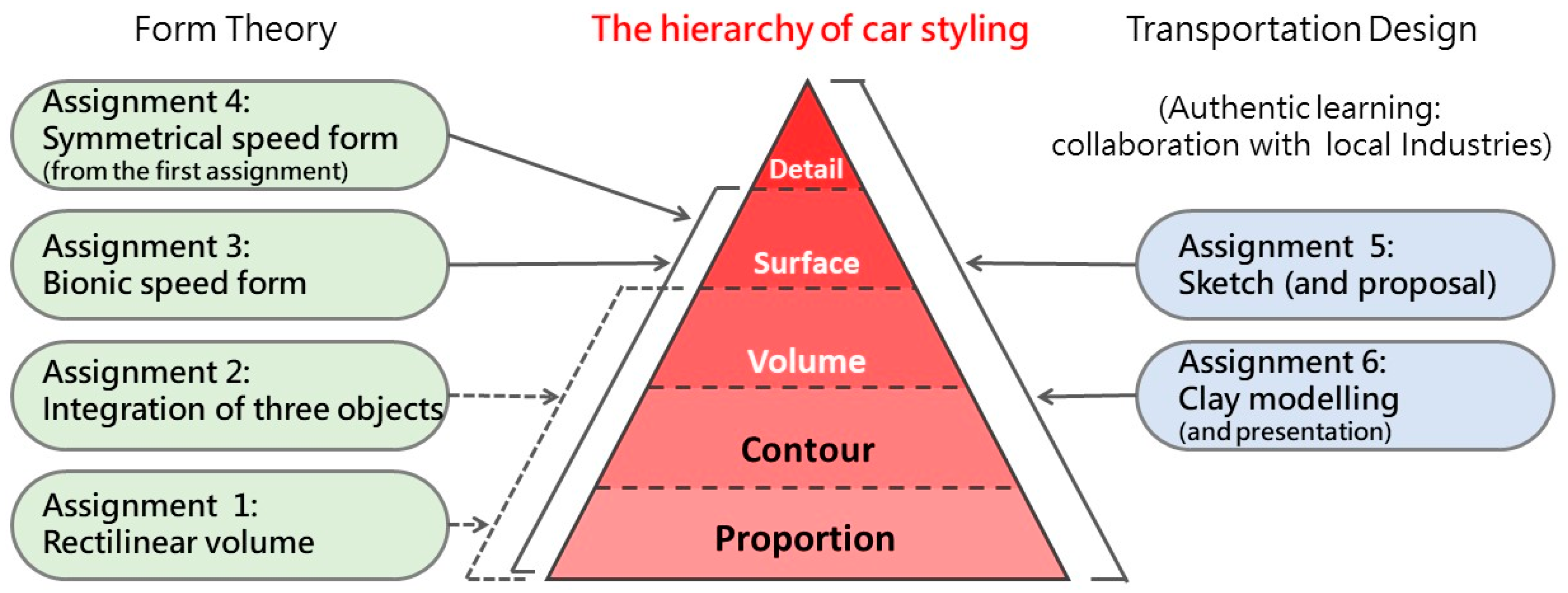
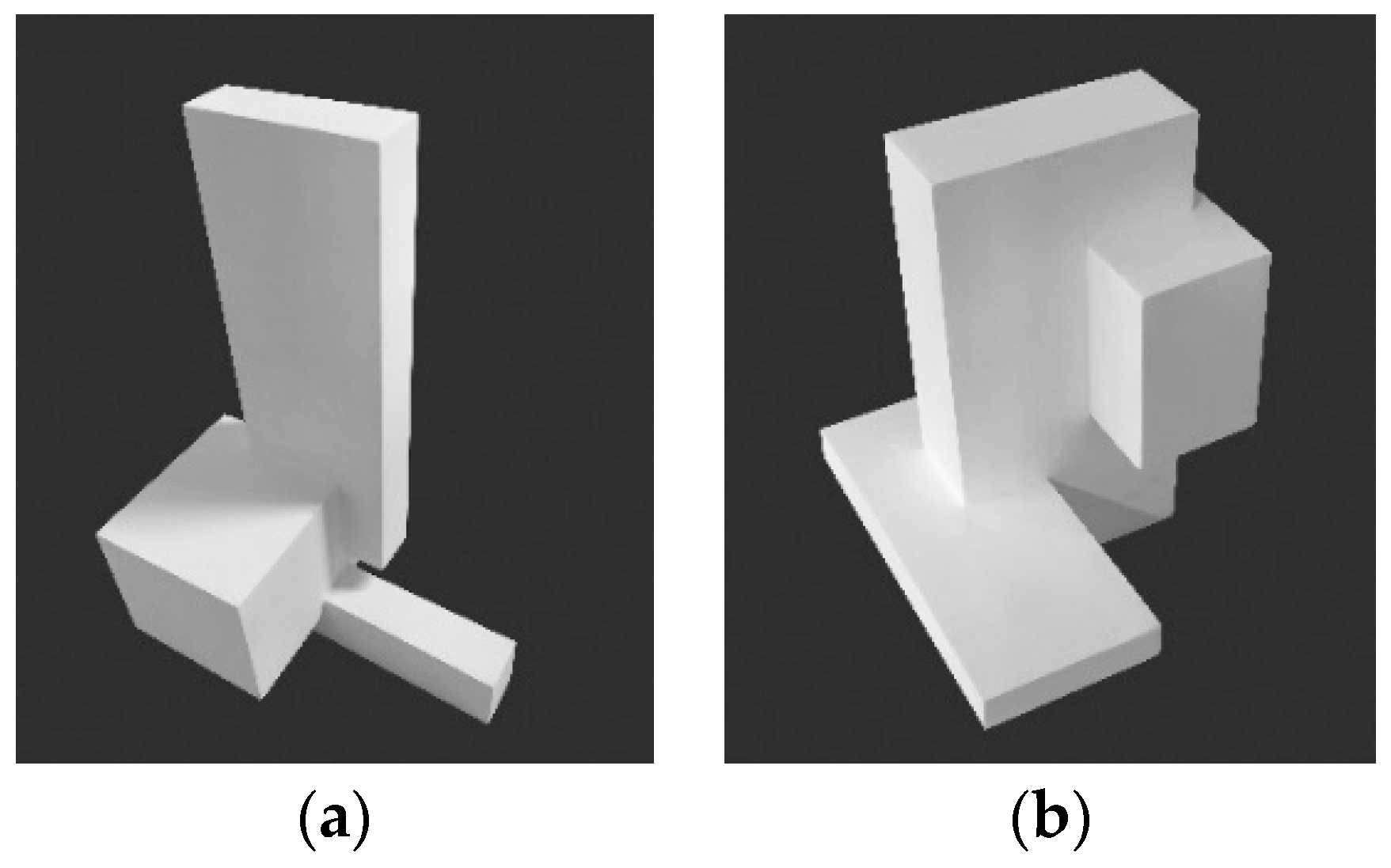
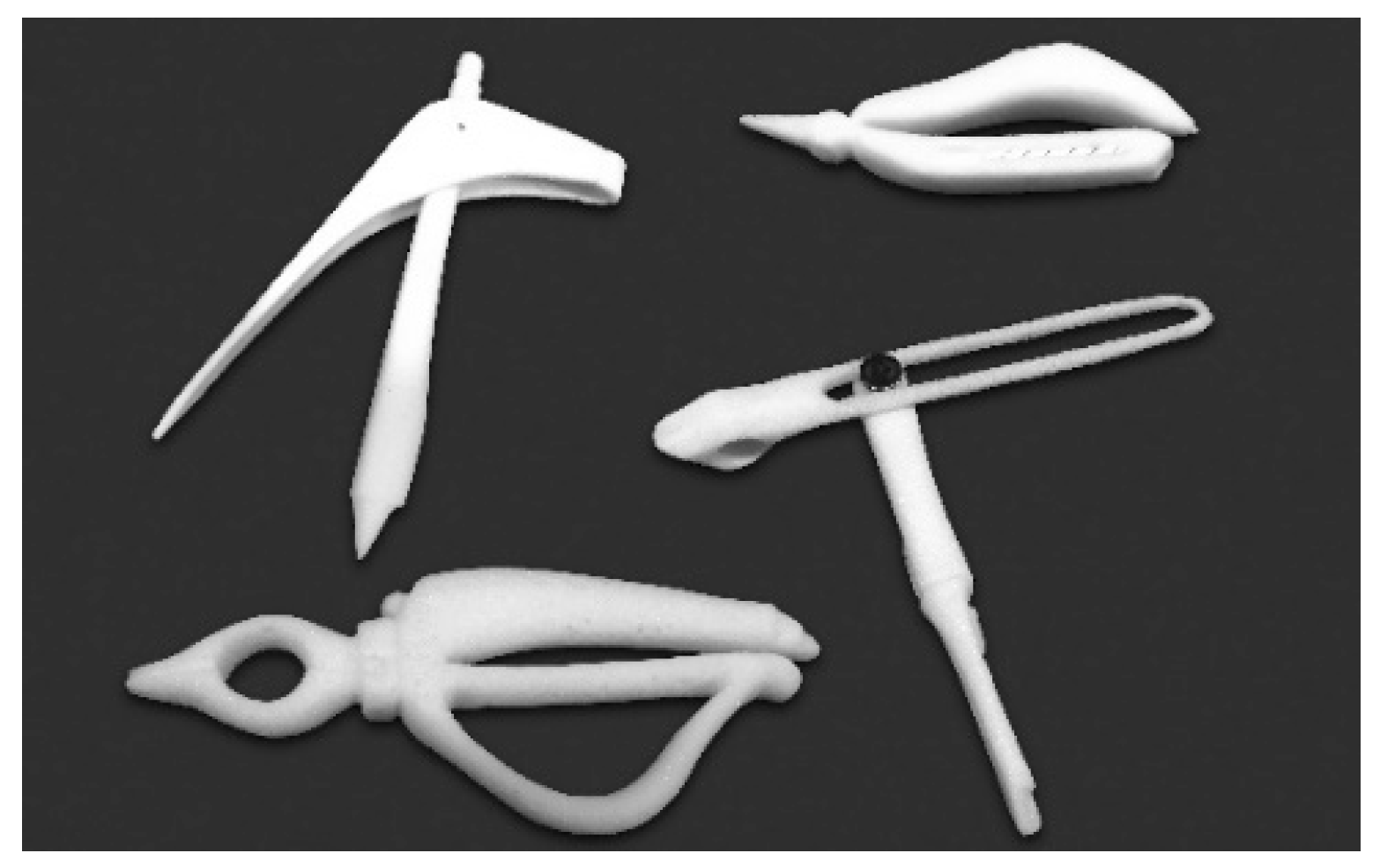

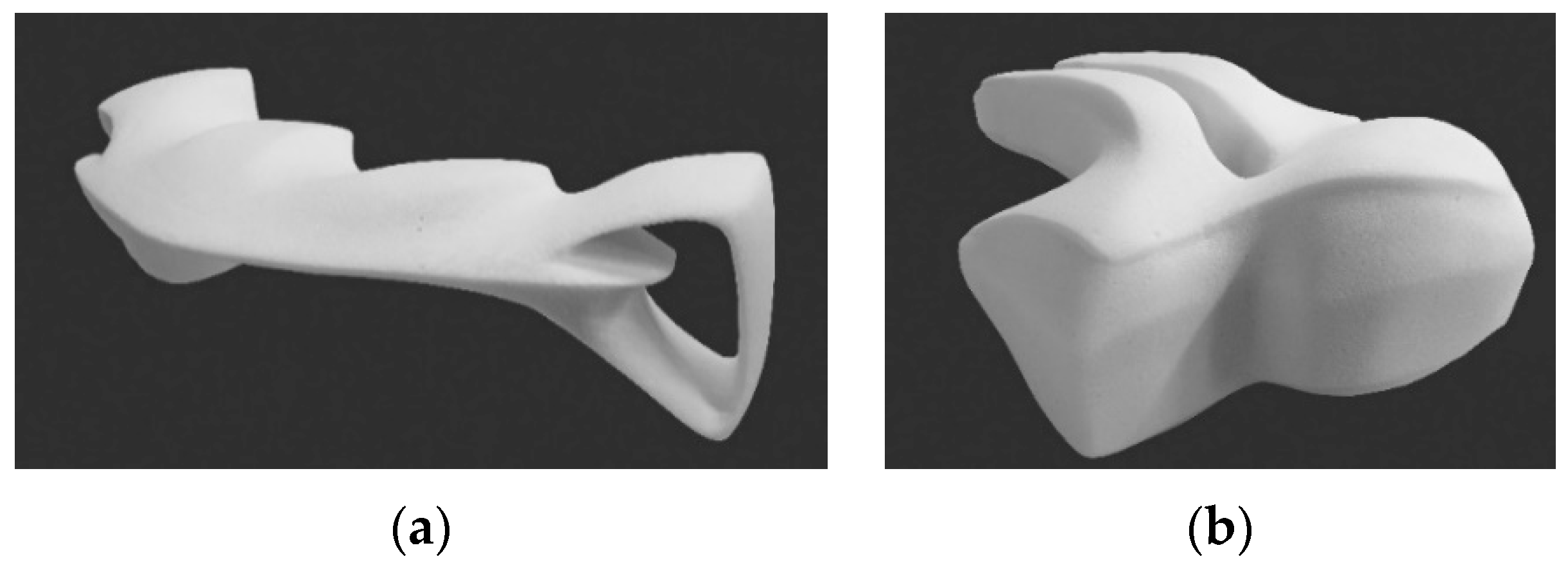

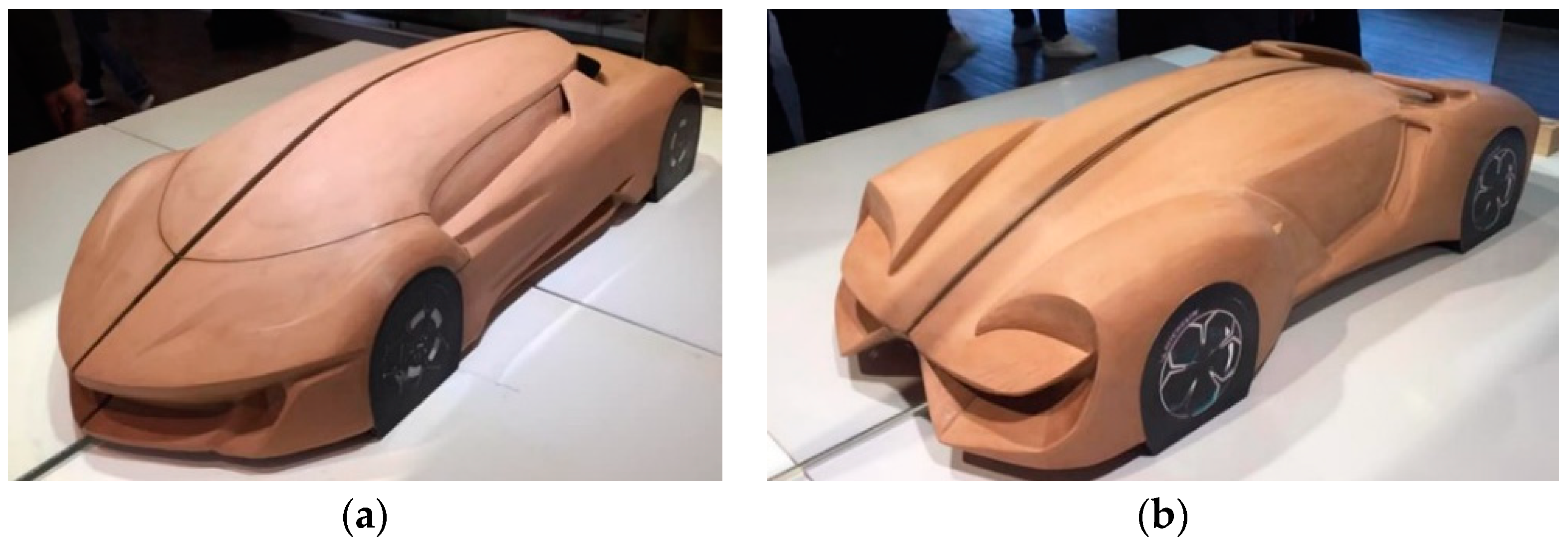
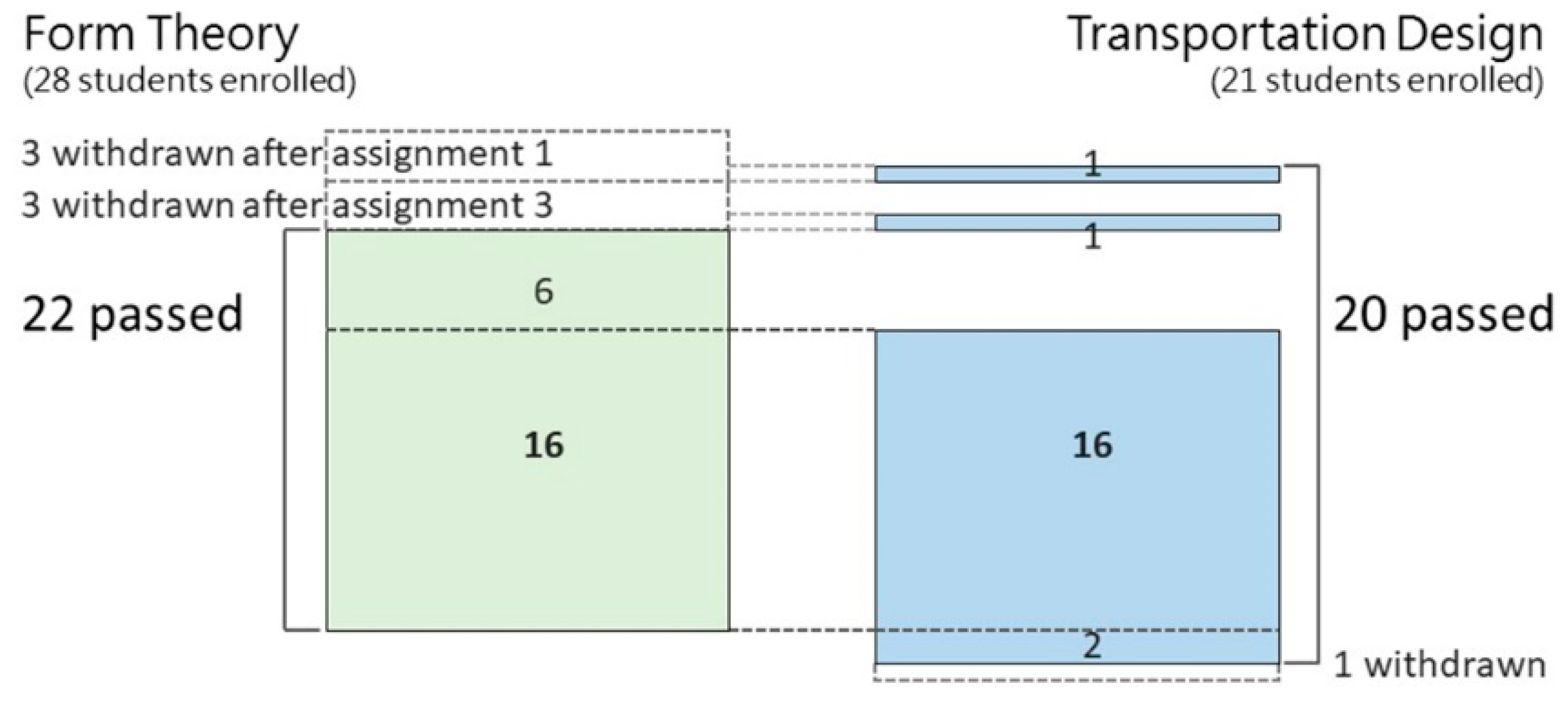
| No. | Question |
|---|---|
| Q1 | My understanding of ‘factor’ has improved from before. |
| Q2 | I have more confidence to deal with the ‘factors’ after finishing the assignment. |
| Q3 | Dealing with the ‘factors’ in this assignment is helpful for the core design course. |
| Assignment | Factor | Q1: Improved Understanding | Q2: More Confidence | Q3: Helpful for the Core Course |
|---|---|---|---|---|
| 1: 5.581 (0.794) | Proportion | 5.727 (0.767) | 5.272 (0.827) | 5.500 (0.964) |
| Contour | 5.818 (0.664) | 5.681 (0.646) | 5.591 (0.959) | |
| Volume | 5.681 (0.646) | 5.364 (0.790) | 5.591 (0.796) | |
| 2: 5.520 (0.927) | Proportion | 5.500 (0.673) | 5.227 (0.869) | 5.773 (0.922) |
| Contour | 5.727 (0.985) | 5.545 (0.912) | 5.818 (0.733) | |
| Volume | 5.364 (1.093) | 5.045 (1.133) | 5.681 (0.780) | |
| 3: 5.572 (0.756) | Proportion | 5.636 (0.658) | 5.591 (0.666) | 5.773 (1.020) |
| Contour | 5.818 (0.588) | 5.591 (0.666) | 5.727 (0.752) | |
| Volume | 5.591 (0.590) | 5.182 (0.664) | 5.545 (0.858) | |
| Surface | 5.545 (0.858) | 5.364 (0.848) | 5.500 (0.740) | |
| 4: 5.295 (0.912) | Proportion | 5.227 (0.869) | 5.182 (0.733) | 5.318 (1.086) |
| Contour | 5.409 (0.796) | 5.000 (0.926) | 5.364 (0.902) | |
| Volume | 5.545 (0.789) | 5.136 (0.834) | 5.364 (1.002) | |
| Surface | 5.455 (0.963) | 5.136 (1.125) | 5.409 (0.959) |
| Assignment | N | Subset | |
|---|---|---|---|
| 1 | 2 | ||
| 4 | 66 | 5.39 | |
| 2 | 66 | 5.53 | 5.53 |
| 3 | 66 | 5.68 | |
| 1 | 66 | 5.74 | |
| Sig. | 0.310 | 0.137 | |
| Assignment | N | Subset | |
|---|---|---|---|
| 1 | 2 | ||
| 4 | 66 | 5.11 | |
| 2 | 66 | 5.27 | 5.27 |
| 1 | 66 | 5.44 | |
| 3 | 66 | 5.45 | |
| Sig. | 0.242 | 0.231 | |
| Assignment | Number | Subset | |
|---|---|---|---|
| 1 | 2 | ||
| 4 | 66 | 5.35 | |
| 1 | 66 | 5.56 | 5.56 |
| 3 | 66 | 5.70 | |
| 2 | 66 | 5.76 | |
| Sig. | 0.179 | 0.241 | |
| Assignment | Proportion | Contour | Volume | Surface | Detail |
|---|---|---|---|---|---|
| 5: Idea sketching 5.94 (0.827) | 6.05 (0.887) | 6.05 (0.826) | 5.90 (0.718) | 5.80 (0.834) | 5.90 (0.912) |
| 6: Clay modeling 6.00 (0.829) | 6.05 (0.686) | 5.95 (0.887) | 6.30 (0.657) | 6.15 (0.671) | 5.55 (1.050) |
| Factor | N | Subset for Alpha = 0.05 | |
|---|---|---|---|
| 1 | 2 | ||
| Detail | 20 | 5.55 | |
| Contour | 20 | 5.95 | |
| Proportion | 20 | 6.05 | 6.05 |
| Surface | 20 | 6.15 | |
| Volume | 20 | 6.30 | |
| Sig. | 0.066 | 0.216 | |
| Assignment 1 | Assignment 2 | Assignment 3 | Assignment 4 | |
|---|---|---|---|---|
| Mean (Std. Deviation) | 5.00 (0.894) | 4.81 (0.834) | 6.19 (0.655) | 6.00 (6.32) |
| Pair | Mean (Std. Deviation) | Std. Error Mean | t-Value | df (Degree of Freedom) | Sig. (Two-Tailed) |
|---|---|---|---|---|---|
| AED_Asg.1- AED_Asg.2 | 0.188 (0.911) | 0.228 | 0.824 | 15 | 0.423 |
| AED_Asg.1- AED_Asg.3 | −1.188 (0.981) | 0.245 | −4.842 | 15 | 0.000 |
| AED_Asg.1- AED_Asg.4 | −1.000 (1.095) | 0.274 | −3.651 | 15 | 0.002 |
| AED_Asg.2- AED_Asg.3 | −1.375 (0.806) | 0.202 | −6.822 | 15 | 0.000 |
| AED_Asg.2- AED_Asg.4 | −1.188 (0.834) | 0.209 | −5.694 | 15 | 0.000 |
| AED_Asg.3- AED_Asg.4 | 0.188 (0.750) | 0.188 | 1.000 | 15 | 0.333 |
© 2019 by the authors. Licensee MDPI, Basel, Switzerland. This article is an open access article distributed under the terms and conditions of the Creative Commons Attribution (CC BY) license (http://creativecommons.org/licenses/by/4.0/).
Share and Cite
Cheng, S.-H.; Ma, Y.-C.; Tseng, W.S.-W. Difference between Learning Basic Form Generation and Automotive Exterior Design. Educ. Sci. 2019, 9, 71. https://doi.org/10.3390/educsci9020071
Cheng S-H, Ma Y-C, Tseng WS-W. Difference between Learning Basic Form Generation and Automotive Exterior Design. Education Sciences. 2019; 9(2):71. https://doi.org/10.3390/educsci9020071
Chicago/Turabian StyleCheng, Shih-Hung, Yung-Chuan Ma, and Winger Sei-Wo Tseng. 2019. "Difference between Learning Basic Form Generation and Automotive Exterior Design" Education Sciences 9, no. 2: 71. https://doi.org/10.3390/educsci9020071
APA StyleCheng, S.-H., Ma, Y.-C., & Tseng, W. S.-W. (2019). Difference between Learning Basic Form Generation and Automotive Exterior Design. Education Sciences, 9(2), 71. https://doi.org/10.3390/educsci9020071




